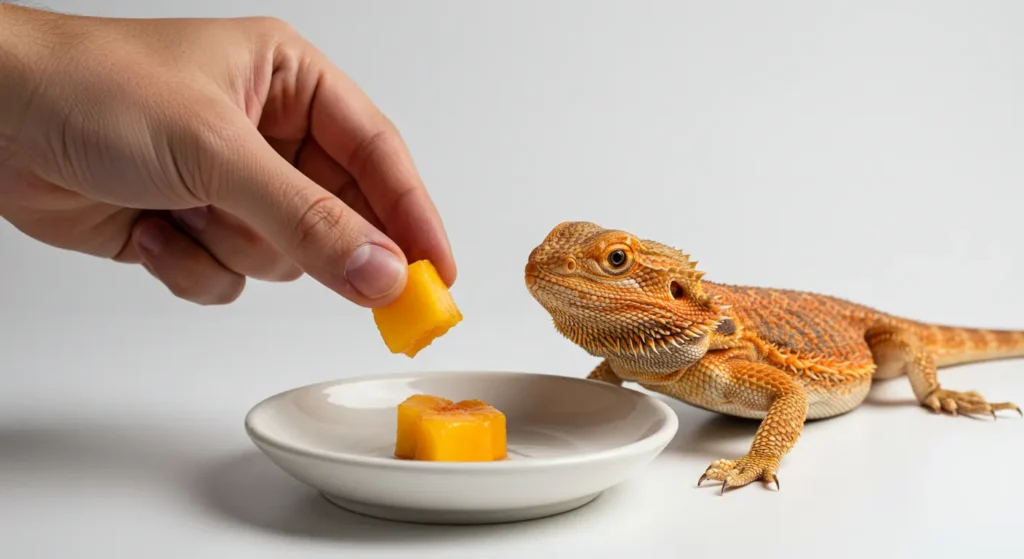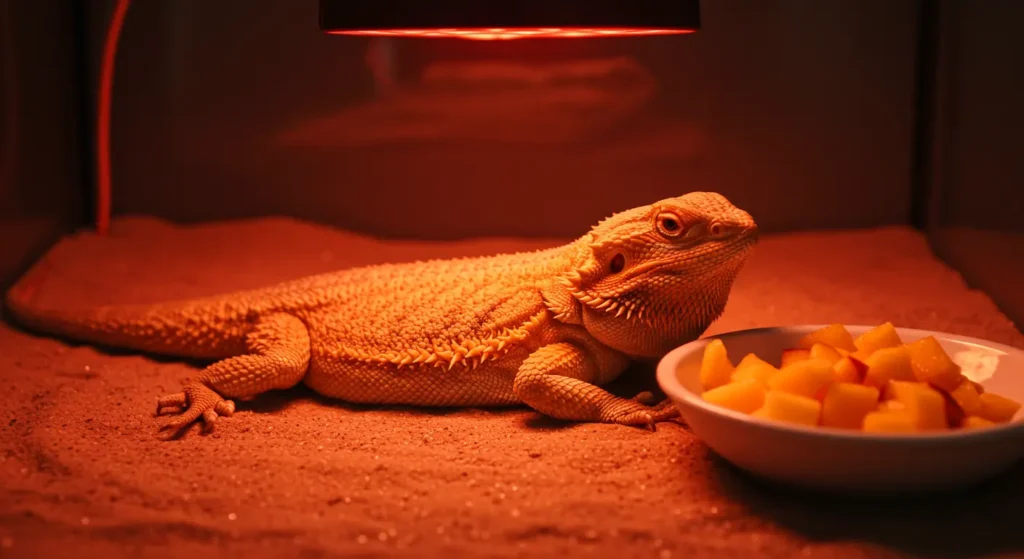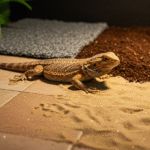Can bearded dragons eat peaches? Many reptile owners ask this when they want to offer their pet a sweet and juicy snack. If you have a male or female bearded dragon, it’s important to understand which fruits are safe—and which might cause problems.
You might see your beardie curious about a peach slice and wonder, can bearded dragons eat peaches without any risk? Peaches may look harmless, but they come with certain nutritional concerns.
This post explains whether male and female bearded dragons can eat peaches safely. You’ll also learn how much to serve, how often, and what signs to watch for after feeding.
Can Bearded Dragons Eat Peaches Safely?
Peaches might seem like a refreshing treat, but can bearded dragons eat peaches safely? In this section, we’ll break down the potential risks and benefits to help you decide whether this fruit belongs in your bearded dragon’s diet.
Are Peaches Safe or Risky for Bearded Dragons?
Peaches can be safe for bearded dragons, but only in small amounts and on occasion. This fruit contains vitamins like A and C, along with fiber and water—helpful in moderation. However, peaches are also high in natural sugar and have a poor calcium-to-phosphorus ratio, which makes them risky if fed too often.
Too much sugar may lead to obesity, digestive upset, or liver strain in reptiles. The phosphorus in peaches can also interfere with calcium absorption. Over time, this imbalance might contribute to metabolic bone disease (MBD), especially if your dragon’s overall diet lacks proper supplementation.
In short, peaches are a “sometimes” food. Use them as a rare treat—not a dietary staple. Always combine fruit treats with a healthy mix of greens, insects, and supplements to maintain your bearded dragon’s health.
What Makes Peaches a Commonly Asked Fruit for Reptiles?
Many reptile owners wonder about peaches because they’re soft, sweet, and easy to prepare. Bearded dragons often show interest in colorful fruits, and peaches have a strong aroma that can stimulate their appetite. That’s why people frequently ask if they can offer peaches to their dragons.
In addition, peaches are affordable and widely available, making them a convenient option in many households. Since bearded dragons can eat some fruits, it’s natural for owners to ask, “Can bearded dragons eat peaches too?”
Despite their popularity, peaches aren’t always the best choice. Their sugar content and poor calcium-to-phosphorus ratio raise concerns. The frequent appearance of peaches on fruit-safe lists also adds to the confusion.
It’s important to learn the facts behind the fruit before feeding. That way, you can keep your dragon healthy while still offering the occasional treat.
Can Baby or Juvenile Bearded Dragons Eat Peaches?
Baby and juvenile bearded dragons have different nutritional needs than adults. They need more protein and calcium to support rapid growth and bone development. Because of that, fruit—including peaches—should be limited or avoided in their early diet.
Feeding peaches to young dragons can introduce too much sugar and phosphorus, which may block calcium absorption. This could increase the risk of serious health issues like metabolic bone disease. Their smaller digestive systems are also more sensitive to dietary changes.
If you choose to offer a tiny amount of peach, make sure it’s fresh, peeled, and finely chopped. Only give it as an occasional treat—no more than once every few weeks—and always alongside calcium-rich vegetables and live insects.
In general, focus on nutrient-dense foods for baby and juvenile dragons. Peaches can wait until your beardie is older and more stable in its dietary routine.
Signs Your Beardie May Not Tolerate Peaches Well
Not all bearded dragons respond well to fruit, and peaches are no exception. After feeding peaches, monitor your beardie closely for changes in behavior or digestion. Signs of intolerance may include loose stool, bloating, lethargy, or loss of appetite.
Some bearded dragons may also react to the sugar or fiber content with mild gastrointestinal distress. If you notice runny droppings or unusual activity after feeding peaches, stop immediately and return to a regular, safe diet.
In rare cases, if your dragon shows signs of discomfort, such as refusing food or staying hidden more than usual, it may be reacting negatively to the fruit. Always offer new foods in small portions and wait 24–48 hours to observe any side effects.
Every bearded dragon is different. What works for one may not work for another. If in doubt, consult a reptile vet to ensure your pet’s diet is safe and well-balanced.
Nutritional Content of Peaches and What It Means for Reptiles
Peaches may taste sweet, but what do they really offer in terms of nutrition for reptiles? In this section, we’ll explore the key nutrients in peaches—like vitamins, sugar, and calcium—and explain how they affect your bearded dragon’s health.
Vitamins and Minerals Found in Peaches
Peaches offer several vitamins and minerals that can benefit your bearded dragon—if fed in moderation. These fruits are rich in vitamin C, which supports immune health, and contain small amounts of vitamin A, vitamin E, potassium, and magnesium. These nutrients can help with hydration, digestion, and skin health.
However, vitamin A must be watched carefully. Too much can lead to vitamin A toxicity, especially if your dragon already receives multivitamin supplements. The mineral content in peaches is also minimal compared to leafy greens and feeder insects.
While peaches may provide hydration due to their high water content, they shouldn’t replace more nutritious staples. Think of them as a light, occasional supplement—not a reliable source of essential nutrients.
If you choose to include peaches in your dragon’s diet, pair them with calcium-rich vegetables and dusted insects. This approach ensures that your reptile receives complete, balanced nutrition without over-relying on fruit.
Understanding Oxalic Acid and Its Risks
Oxalic acid is a naturally occurring compound in many fruits and vegetables, including peaches. In small doses, it’s not dangerous. But when consumed in excess, oxalic acid binds to calcium in your bearded dragon’s body and blocks its absorption.
This interference can lead to calcium deficiency, which increases the risk of metabolic bone disease (MBD)—a painful and potentially life-threatening condition in reptiles. Since bearded dragons rely heavily on calcium for bone strength, too much oxalate in their diet is a major concern.
Peaches contain moderate levels of oxalic acid, which makes them safer than spinach but still not ideal for frequent feeding. When you offer peaches, make sure they don’t replace calcium-rich vegetables like collard greens or dandelion leaves.
Limiting oxalate-heavy foods and providing proper UVB lighting can help your dragon absorb and use calcium more effectively. Always aim for a low-oxalate, high-calcium diet to maintain your pet’s skeletal and muscular health.
Sugar Content and Its Effects on Reptile Health
Peaches are naturally sweet, and that sweetness comes from sugar. While the sugar in fruit is natural, it can still be too much for bearded dragons, especially when fed often. High sugar intake can lead to obesity, fatty liver disease, and digestive problems in reptiles.
Unlike mammals, reptiles like bearded dragons don’t process sugar the same way. Their metabolism is slower, and their natural diet includes very little fruit. Too much sugar causes spikes in energy, followed by crashes, which may affect their appetite and activity levels.
Baby and juvenile dragons are especially vulnerable to sugar-related issues. Their bodies are still developing, and extra sugar can harm their growth.
Peaches should be offered as a treat—no more than once every few weeks. Remove the skin and serve only a small, bite-sized amount. Pair sweet treats with leafy greens and calcium-rich feeders to keep your dragon’s nutrition in check.
The Calcium to Phosphorus Ratio: Why It Matters
The calcium to phosphorus ratio in food is critical for bearded dragons. Ideally, reptiles need a 2:1 ratio of calcium to phosphorus for proper bone development and metabolic health. Unfortunately, peaches have an inverted ratio, meaning they contain more phosphorus than calcium.
When phosphorus levels are too high, they interfere with calcium absorption. Over time, this can lead to metabolic bone disease (MBD), especially if your dragon’s diet is already low in calcium or lacks proper UVB lighting.
Feeding peaches occasionally won’t hurt, but offering them too often can tip the balance in the wrong direction. This is why peaches should never be a staple fruit in your dragon’s routine.
To maintain a healthy ratio, focus on feeding calcium-rich vegetables like mustard greens, collards, or turnip greens. Use calcium powder supplements and avoid combining peaches with other phosphorus-rich foods. Balance is key in preventing nutritional deficiencies and long-term health problems.
Feeding Peaches to Bearded Dragons: Best Practices
Feeding fruit to reptiles requires care—and peaches are no exception. In this section, we’ll cover the best practices for feeding peaches to bearded dragons, including how to prepare them, how much to serve, and how often to offer this sweet treat safely.
How Much Peach Is Safe to Serve?
Peaches should only be offered in very small amounts—no more than a few small bites at a time. A good rule of thumb is to offer pieces no larger than the space between your bearded dragon’s eyes. For adults, this might mean one or two small chunks. For juveniles, just a single piece is enough.
Serving too much peach can introduce too much sugar and phosphorus into your dragon’s diet. This may lead to digestive upset or nutrient imbalances over time. Always think of peaches as an occasional treat, not a regular meal.
Cut the peach into soft, manageable pieces. Offer it in a shallow dish or by hand, but make sure the fruit is fresh and ripe. Avoid overfeeding even if your dragon seems to enjoy the taste. Balanced portion sizes help maintain long-term health.

Should You Peel or Cut Peaches Before Feeding?
Yes—you should always peel and cut peaches before feeding them to your bearded dragon. The skin, while edible for humans, may contain pesticides or wax coatings that are hard for reptiles to digest. Even organic fruit can carry residue from transport or handling.
After peeling, slice the peach into tiny, soft chunks. Avoid large or slippery pieces that could pose a choking hazard. Make sure to remove the pit completely, as it’s not safe to consume and presents a serious risk of impaction or injury.
Cutting the fruit into small, even portions makes it easier for your dragon to chew and digest. This also helps you control serving size. Always serve peaches raw and at room temperature. Avoid cooking, seasoning, or mixing with other sugary foods.
Fresh vs. Dried vs. Canned Peaches: What’s Best?
When it comes to feeding peaches to bearded dragons, fresh is always best. Fresh peaches contain water, vitamins, and fiber in their most natural state. They are the safest option when fed in moderation.
Dried peaches are not recommended. They contain concentrated sugars, very little moisture, and sometimes added preservatives. Feeding dried fruit can cause digestive problems and contribute to obesity.
Canned peaches are even riskier. Most are stored in heavy syrup, which contains added sugar and chemicals. Even if labeled “no sugar added,” canned fruits often include preservatives that are harmful to reptiles.
If you’re planning to offer peaches, always choose fresh, ripe, and pesticide-free fruit. Wash and peel the skin, cut it into small bites, and serve it plain. Avoid dried or canned versions entirely to protect your dragon’s digestive and metabolic health.
How Often Can Bearded Dragons Eat Peaches?
Bearded dragons should only eat peaches occasionally—no more than once every two to three weeks. While they may enjoy the taste, peaches are high in sugar and low in calcium, which can lead to long-term health problems if fed too often.
Feeding peaches too frequently increases the risk of calcium deficiency, digestive upset, and weight gain. These issues can weaken your dragon’s bones and immune system over time.
Treat peaches like a reward, not a staple. Rotate them with other safer fruit options like blueberries, raspberries, or small amounts of papaya. Always offer them in small amounts and alongside a healthy mix of insects and leafy greens.
Monitoring how often your bearded dragon eats fruit helps maintain a balanced diet. When in doubt, less is better—especially with sugary fruits like peaches.
Are Peaches the Right Fruit for Your Bearded Dragon’s Diet?
Not all fruits are created equal when it comes to reptile diets. In this section, we’ll explore whether peaches are truly the right fit for your bearded dragon’s long-term nutrition—and how they compare to other fruit options in terms of safety and value.
Comparing Peaches to Other Safe Fruits
Peaches are one of many fruits that can be offered to bearded dragons in moderation. But how do they compare to other safe options like blueberries, raspberries, or papaya?
Unlike peaches, fruits like berries are lower in sugar and contain more antioxidants. Papaya offers a better calcium-to-phosphorus ratio and is easier to digest. Apples, if peeled and sliced thinly, are safe too, but they also contain a fair amount of sugar and should be limited.
Peaches fall somewhere in the middle. They offer hydration and vitamin C but are high in sugar and low in calcium. Their oxalate content also makes them less ideal than other choices.
When selecting fruit, prioritize options that are low in sugar and rich in beneficial nutrients. Rotate them carefully and always serve small portions. While peaches are not the worst fruit you can offer, they’re definitely not the best either.
When to Avoid Feeding Fruit to Your Beardie
There are times when feeding fruit, including peaches, should be avoided entirely. If your bearded dragon is ill, recovering from stress, or showing signs of digestive upset, it’s best to stick to a bland, leafy vegetable and protein-based diet.
Young dragons also need more protein and calcium than sugar. Offering peaches too early may interfere with their development. Avoid fruit during brumation or periods of inactivity, as the digestive system slows down and sugar can cause problems.
If your dragon already suffers from obesity, metabolic bone disease (MBD), or liver issues, eliminate fruit completely until cleared by a reptile vet. These conditions worsen with sugar and calcium imbalances.
Fruit is not an essential part of your dragon’s diet. It’s a bonus, not a need. Use it only when your pet is healthy and thriving, and even then, serve in very small portions. Monitoring your beardie’s health is key to knowing when fruit is safe—or when it’s best to skip it.
How Fruit Fits into a Balanced Reptile Diet
Fruit plays a small but enjoyable role in a bearded dragon’s diet—when used correctly. The majority of their nutrition should come from leafy greens, safe vegetables, and live insects. These provide the protein, calcium, and hydration they need to stay healthy.
Fruits like peaches can be offered as occasional treats. They provide natural sugar and some hydration but lack many essential minerals. Too much fruit can create imbalances, especially if it replaces more nutritious foods.
A healthy adult dragon can handle a small amount of fruit once every week or two. Juveniles should receive even less. Always pair fruit with calcium-rich greens and dusted feeder insects to support overall health.
When planning meals, think of fruit as a side item—not the main dish. That mindset will help you keep your bearded dragon’s diet balanced and disease-free.
Health Conditions That May Worsen with Fruit Intake
Certain health issues in bearded dragons can become worse with fruit consumption. For example, metabolic bone disease (MBD) is caused by low calcium levels. Since peaches are low in calcium and high in phosphorus, they can aggravate this condition.
Obesity is another risk. High-sugar fruits like peaches can contribute to weight gain, especially in less active dragons. If your beardie is already overweight or has fatty liver disease, avoid feeding sugary treats entirely.
Digestive problems such as diarrhea, bloating, or impaction may also worsen after fruit intake. Peaches contain fiber and water, which can disrupt digestion if overfed.
Dragons with compromised immune systems or those recovering from illness should also avoid fruit. Their bodies need more nutrients and less sugar to heal properly.
Always monitor your dragon after feeding fruit. If you notice any changes in behavior or stool, stop offering it and consult a reptile veterinarian.
Expert Advice on Feeding Peaches to Bearded Dragons
What Reptile Vets Say About Peaches in a Beardie’s Diet
Reptile veterinarians generally agree that peaches are safe in small, occasional portions. They emphasize that peaches should never become a regular part of your bearded dragon’s diet due to their high sugar content and poor calcium-to-phosphorus ratio.
According to most herpetology experts, fruits like peaches should make up no more than 5–10% of your bearded dragon’s overall diet. The rest should consist of leafy greens, vegetables, and insect protein. Vets also stress the importance of avoiding dried or canned peaches, as these often contain added sugar or preservatives that can harm your pet.
In cases where dragons already suffer from metabolic bone disease or obesity, vets recommend cutting out fruit completely. They also suggest monitoring your dragon closely after introducing any new food—especially sugary fruit.
The bottom line from vets: Yes, bearded dragons can eat peaches, but only in tiny amounts and not frequently. Balance is key.
Advice from Experienced Bearded Dragon Owners
Long-time bearded dragon owners often share similar tips about feeding peaches. Most agree that their dragons enjoy the taste, but they also caution against offering it too often. The sweetness and moisture make peaches tempting, but experienced keepers know that moderation is essential.
Many owners recommend peeling the peach, cutting it into tiny cubes, and offering it no more than once every two or three weeks. They also advise watching for any changes in digestion or appetite after feeding. If anything seems off, it’s best to stop offering the fruit.
Some owners prefer to rotate fruit choices and limit sugary options like peaches in favor of safer ones—such as blueberries or papaya. They also highlight the importance of pairing any fruit treat with calcium-dusted insects and nutrient-rich greens.
In forums and groups, the general consensus is clear: can bearded dragons eat peaches? Yes—but rarely, and always with caution.
FAQs: Can Bearded Dragons Eat Peaches with the Skin?
Yes, bearded dragons can technically eat peach skin, but it’s not recommended. The outer peel may contain pesticide residue, wax, or other chemicals—even if the fruit is organic. It’s also tougher to digest than the soft fruit inside.
Most reptile experts and owners suggest peeling the peach before serving it. This step helps reduce the risk of digestive irritation or impaction. Even a small piece of skin can be too rough for younger or smaller dragons to process properly.
If you choose to serve peaches with the skin, make sure the fruit is washed thoroughly and cut into very thin slices. But the safer route is to remove the skin entirely and only offer the soft, ripe interior of the fruit.
When in doubt, skip the peel. Your dragon won’t miss it, and you’ll reduce the risk of unnecessary complications.
Red Flags After Feeding Peaches – When to Call the Vet
After feeding your bearded dragon peaches, monitor them closely. While most dragons tolerate small amounts, some may show signs of digestive trouble or sugar sensitivity.
Common red flags include runny or discolored stool, bloating, lethargy, or loss of appetite. If your dragon stops eating or becomes unusually inactive, this could indicate that the peach didn’t agree with them. Vomiting or signs of impaction—such as straining during bowel movements—are more serious and require immediate attention.
If any of these symptoms appear within 24–48 hours after feeding, stop giving peaches and return to a safe, bland diet of greens and insects. If the issues persist, contact a reptile veterinarian right away.
It’s better to act early than wait for symptoms to worsen. Bearded dragons can decline quickly if something is wrong, especially when their diet is the cause.

Conclusion: Can Bearded Dragons Eat Peaches?
So, can bearded dragons eat peaches? Yes—but only in moderation and with care. While peaches offer hydration and a few helpful nutrients, they also come with risks like high sugar content, oxalates, and a poor calcium-to-phosphorus ratio. These factors make them a treat, not a staple.
Both male and female bearded dragons can enjoy small pieces of fresh, peeled peach from time to time. However, it’s important to watch for any digestive issues and avoid canned or dried varieties entirely. If your beardie has existing health concerns, it’s best to skip fruit altogether and stick to a balanced diet of leafy greens, vegetables, and calcium-rich insects.
In the end, a healthy bearded dragon thrives on variety, balance, and moderation. By understanding what fruits like peaches bring to the table, you can offer safe, occasional treats without compromising your reptile’s long-term health.







3 thoughts on “Can Bearded Dragons Eat Peaches? Everything You Need to Know”